Comprehensive Analysis of HRM Practices at Morrisons Supermarket
VerifiedAdded on 2024/05/30
|27
|5418
|295
Report
AI Summary
This report provides a comprehensive analysis of Human Resource Management (HRM) practices within Morrisons, a leading supermarket chain in the UK. It explores the purpose and functions of HRM, focusing on workforce planning and resourcing, and examines the strengths and weaknesses of different recruitment and selection approaches. The report details the benefits of various HRM practices for both employers and employees, including employee retention, employee relations, performance management, and training programs, and evaluates their effectiveness in raising organizational profit and productivity. Furthermore, it analyzes the importance of employee relations in influencing HRM decision-making and identifies key elements of employment legislation and their impact on HR decisions. The report also demonstrates the practical applications of HRM practices within Morrisons, evaluating their processes and relationships with relevant examples. The analysis emphasizes the role of HRM in developing employees, increasing morale and motivation, and fostering a positive work environment.
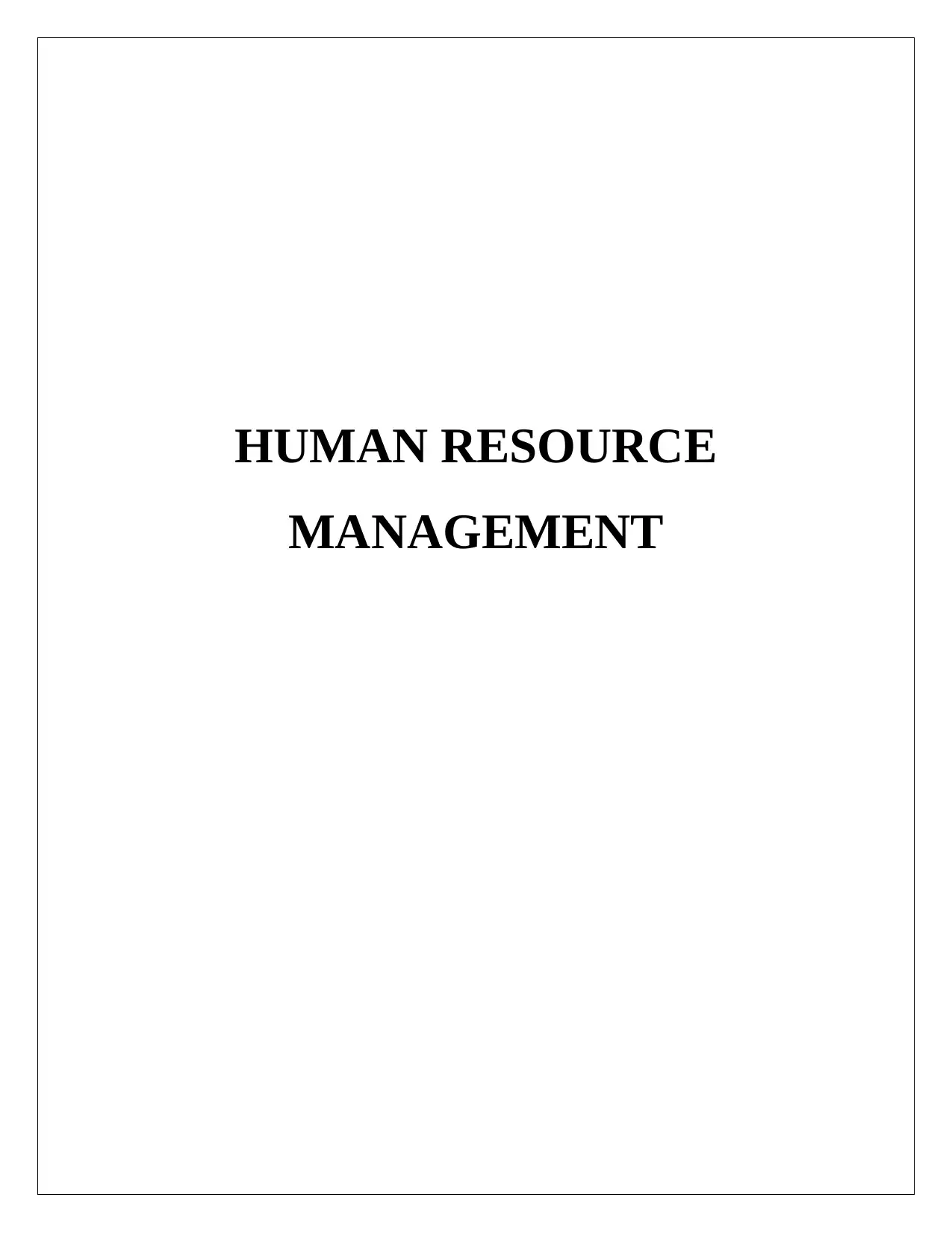
HUMAN RESOURCE
MANAGEMENT
MANAGEMENT
Paraphrase This Document
Need a fresh take? Get an instant paraphrase of this document with our AI Paraphraser
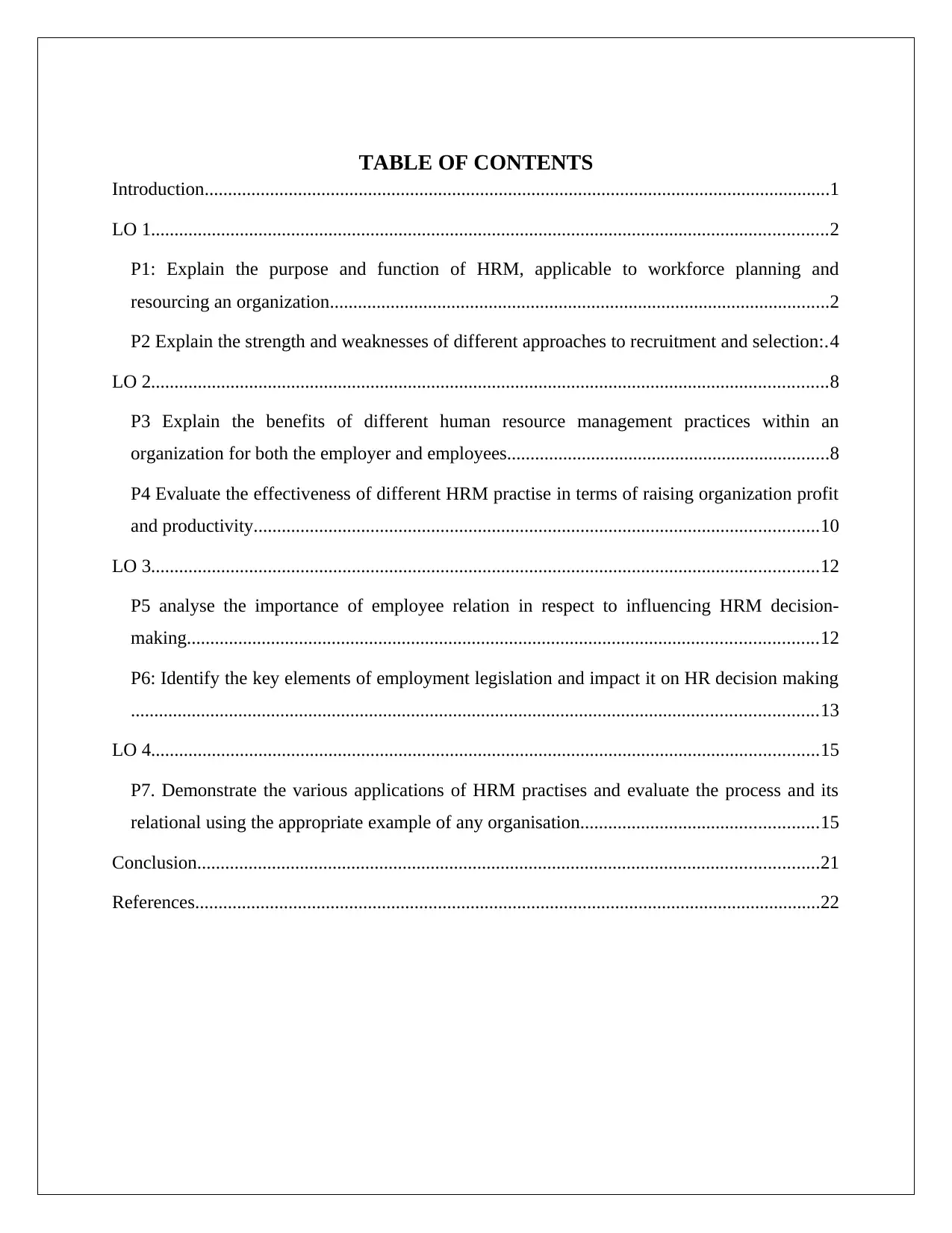
TABLE OF CONTENTS
Introduction......................................................................................................................................1
LO 1.................................................................................................................................................2
P1: Explain the purpose and function of HRM, applicable to workforce planning and
resourcing an organization...........................................................................................................2
P2 Explain the strength and weaknesses of different approaches to recruitment and selection:.4
LO 2.................................................................................................................................................8
P3 Explain the benefits of different human resource management practices within an
organization for both the employer and employees.....................................................................8
P4 Evaluate the effectiveness of different HRM practise in terms of raising organization profit
and productivity.........................................................................................................................10
LO 3...............................................................................................................................................12
P5 analyse the importance of employee relation in respect to influencing HRM decision-
making.......................................................................................................................................12
P6: Identify the key elements of employment legislation and impact it on HR decision making
...................................................................................................................................................13
LO 4...............................................................................................................................................15
P7. Demonstrate the various applications of HRM practises and evaluate the process and its
relational using the appropriate example of any organisation...................................................15
Conclusion.....................................................................................................................................21
References......................................................................................................................................22
Introduction......................................................................................................................................1
LO 1.................................................................................................................................................2
P1: Explain the purpose and function of HRM, applicable to workforce planning and
resourcing an organization...........................................................................................................2
P2 Explain the strength and weaknesses of different approaches to recruitment and selection:.4
LO 2.................................................................................................................................................8
P3 Explain the benefits of different human resource management practices within an
organization for both the employer and employees.....................................................................8
P4 Evaluate the effectiveness of different HRM practise in terms of raising organization profit
and productivity.........................................................................................................................10
LO 3...............................................................................................................................................12
P5 analyse the importance of employee relation in respect to influencing HRM decision-
making.......................................................................................................................................12
P6: Identify the key elements of employment legislation and impact it on HR decision making
...................................................................................................................................................13
LO 4...............................................................................................................................................15
P7. Demonstrate the various applications of HRM practises and evaluate the process and its
relational using the appropriate example of any organisation...................................................15
Conclusion.....................................................................................................................................21
References......................................................................................................................................22

LIST OF FIGURES
Figure 1: Purpose of HRM..............................................................................................................3
Figure 2: Functions of HRM............................................................................................................4
Figure 3: Sources of recruitment.....................................................................................................5
Figure 4: Different practices of HRM..........................................................................................10
Figure 5: Decision making process in HRM.................................................................................13
Figure 6: Ways of recruitment.......................................................................................................19
Figure 7: Type of HRM Practise...................................................................................................20
Figure 1: Purpose of HRM..............................................................................................................3
Figure 2: Functions of HRM............................................................................................................4
Figure 3: Sources of recruitment.....................................................................................................5
Figure 4: Different practices of HRM..........................................................................................10
Figure 5: Decision making process in HRM.................................................................................13
Figure 6: Ways of recruitment.......................................................................................................19
Figure 7: Type of HRM Practise...................................................................................................20
⊘ This is a preview!⊘
Do you want full access?
Subscribe today to unlock all pages.

Trusted by 1+ million students worldwide

LIST OF TABLES
Table 1: Job Description................................................................................................................15
Table 2: Curriculum Vitae.............................................................................................................15
Table 3: Offer Letter......................................................................................................................18
Table 1: Job Description................................................................................................................15
Table 2: Curriculum Vitae.............................................................................................................15
Table 3: Offer Letter......................................................................................................................18
Paraphrase This Document
Need a fresh take? Get an instant paraphrase of this document with our AI Paraphraser
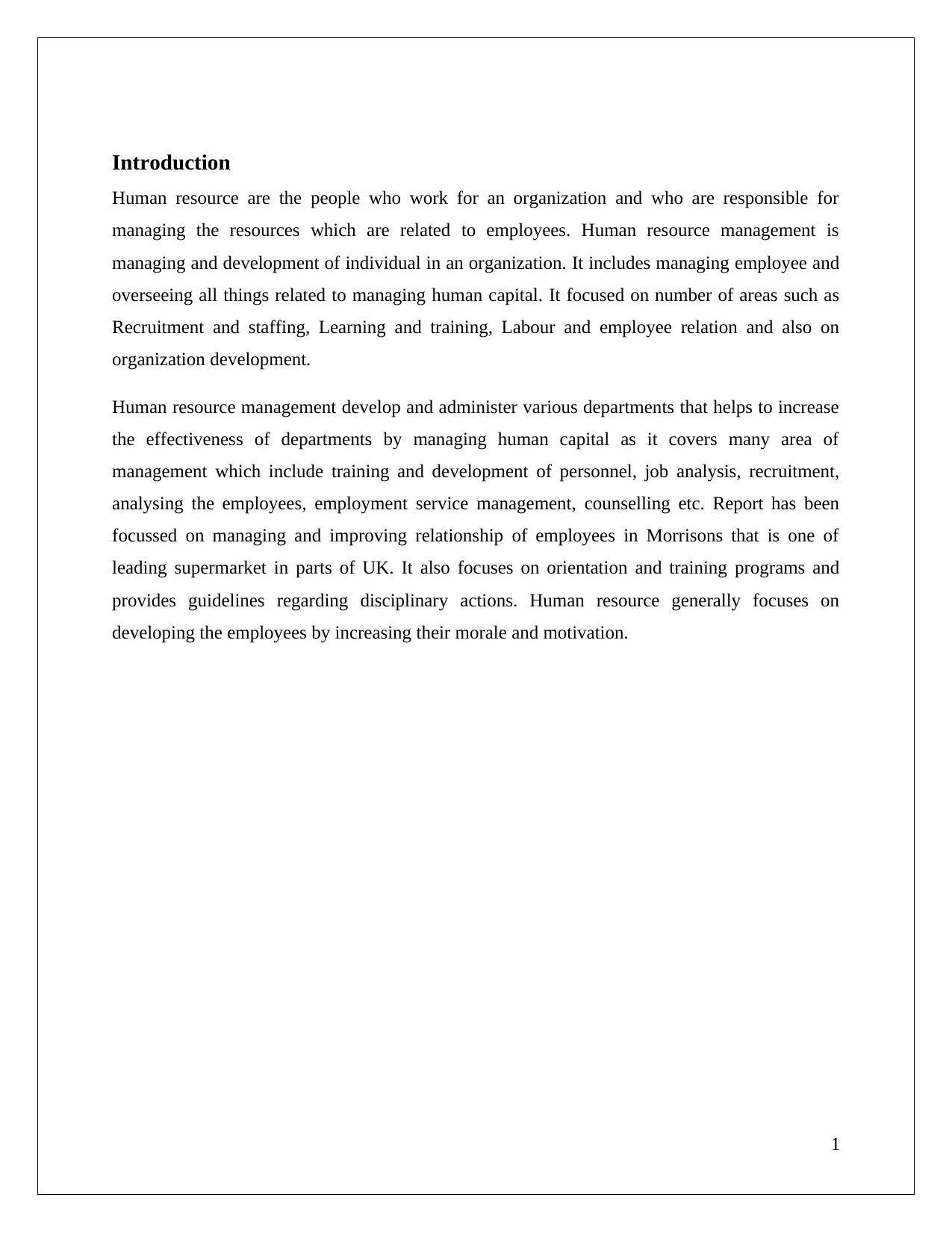
Introduction
Human resource are the people who work for an organization and who are responsible for
managing the resources which are related to employees. Human resource management is
managing and development of individual in an organization. It includes managing employee and
overseeing all things related to managing human capital. It focused on number of areas such as
Recruitment and staffing, Learning and training, Labour and employee relation and also on
organization development.
Human resource management develop and administer various departments that helps to increase
the effectiveness of departments by managing human capital as it covers many area of
management which include training and development of personnel, job analysis, recruitment,
analysing the employees, employment service management, counselling etc. Report has been
focussed on managing and improving relationship of employees in Morrisons that is one of
leading supermarket in parts of UK. It also focuses on orientation and training programs and
provides guidelines regarding disciplinary actions. Human resource generally focuses on
developing the employees by increasing their morale and motivation.
1
Human resource are the people who work for an organization and who are responsible for
managing the resources which are related to employees. Human resource management is
managing and development of individual in an organization. It includes managing employee and
overseeing all things related to managing human capital. It focused on number of areas such as
Recruitment and staffing, Learning and training, Labour and employee relation and also on
organization development.
Human resource management develop and administer various departments that helps to increase
the effectiveness of departments by managing human capital as it covers many area of
management which include training and development of personnel, job analysis, recruitment,
analysing the employees, employment service management, counselling etc. Report has been
focussed on managing and improving relationship of employees in Morrisons that is one of
leading supermarket in parts of UK. It also focuses on orientation and training programs and
provides guidelines regarding disciplinary actions. Human resource generally focuses on
developing the employees by increasing their morale and motivation.
1

LO 1
P1: Explain the purpose and function of HRM, applicable to workforce planning and resourcing
an organization
Purpose of Human resource management is to coordinate people within an organization to
achieve organization goals. Morrisons need to employees to achieve specific objectives by
satisfying their needs with employee satisfaction. It accomplishes its task by use of employees,
process and technology as it focus on its internal environment rather than external environment
(Poba-Nzaou, et.al. 2018). It can follow various fields such as business management, process
management, information technology and statistical analysis for achieving these objectives.
Human resource the management explains the need of management and it protects the rights of
workers.
Internal management of customer: The productivity of employees is depending on quality of
employees working in organization as it has direct relationship with company performance.
Morrisons will tend to focus on serving the customers and creates external relationship. Internal
management of employees helps them to work together collectively and it increase their
productivity and efficiency.
Regulating laws: It follows employment and labour law and it understand labour relationship
and negotiation. It is an HRM duty to structure employee contract and input the firm lawyer
which helps to structure job contracts (Cascio, 2018). Employees feel safe with the contracts and
following the laws by HRM.
Metrics: It interacts with all level of employer in an organization along with the line
management they are active business partner. It also offers and retains the employees by
adopting various techniques in Morrisons
Cultural awareness: HRM maintain cultural awareness and also helps in managing cultural
conflicts (Rauch and Hatak, 2016). It allows hiring candidates from one part of the world to
relocate to another understanding of visas, contracts and red tape.
2
P1: Explain the purpose and function of HRM, applicable to workforce planning and resourcing
an organization
Purpose of Human resource management is to coordinate people within an organization to
achieve organization goals. Morrisons need to employees to achieve specific objectives by
satisfying their needs with employee satisfaction. It accomplishes its task by use of employees,
process and technology as it focus on its internal environment rather than external environment
(Poba-Nzaou, et.al. 2018). It can follow various fields such as business management, process
management, information technology and statistical analysis for achieving these objectives.
Human resource the management explains the need of management and it protects the rights of
workers.
Internal management of customer: The productivity of employees is depending on quality of
employees working in organization as it has direct relationship with company performance.
Morrisons will tend to focus on serving the customers and creates external relationship. Internal
management of employees helps them to work together collectively and it increase their
productivity and efficiency.
Regulating laws: It follows employment and labour law and it understand labour relationship
and negotiation. It is an HRM duty to structure employee contract and input the firm lawyer
which helps to structure job contracts (Cascio, 2018). Employees feel safe with the contracts and
following the laws by HRM.
Metrics: It interacts with all level of employer in an organization along with the line
management they are active business partner. It also offers and retains the employees by
adopting various techniques in Morrisons
Cultural awareness: HRM maintain cultural awareness and also helps in managing cultural
conflicts (Rauch and Hatak, 2016). It allows hiring candidates from one part of the world to
relocate to another understanding of visas, contracts and red tape.
2
⊘ This is a preview!⊘
Do you want full access?
Subscribe today to unlock all pages.

Trusted by 1+ million students worldwide

Figure 1: Purpose of HRM
(Source: Author)
Functions of HRM
There are many function of HRM and there are five major function of human resource
management:
The main function oh HR is recruiting employees by proper screening, qualification
based on criteria of job and to encourage the applicants by providing them knowledge of
their job (Brewster, 2017). Right person at right job will help the applicant to perform
their task well and organized.
The fundamental function which an organization provide is orientation to new
employees as it include objective and goals of organization and it provide guideline to
employees that how they can achieve long term and short term goals.
It is responsibility of them to provide good working condition so that they like the
workplace and work environment (Fay et.al. 2015).
Managing relation with employees is a crucial function of HRM as they ability to
influence behaviours and work output.
3
InternalmanagementofcustomerRegulatinglawsMetricsCulturalawarness
(Source: Author)
Functions of HRM
There are many function of HRM and there are five major function of human resource
management:
The main function oh HR is recruiting employees by proper screening, qualification
based on criteria of job and to encourage the applicants by providing them knowledge of
their job (Brewster, 2017). Right person at right job will help the applicant to perform
their task well and organized.
The fundamental function which an organization provide is orientation to new
employees as it include objective and goals of organization and it provide guideline to
employees that how they can achieve long term and short term goals.
It is responsibility of them to provide good working condition so that they like the
workplace and work environment (Fay et.al. 2015).
Managing relation with employees is a crucial function of HRM as they ability to
influence behaviours and work output.
3
InternalmanagementofcustomerRegulatinglawsMetricsCulturalawarness
Paraphrase This Document
Need a fresh take? Get an instant paraphrase of this document with our AI Paraphraser
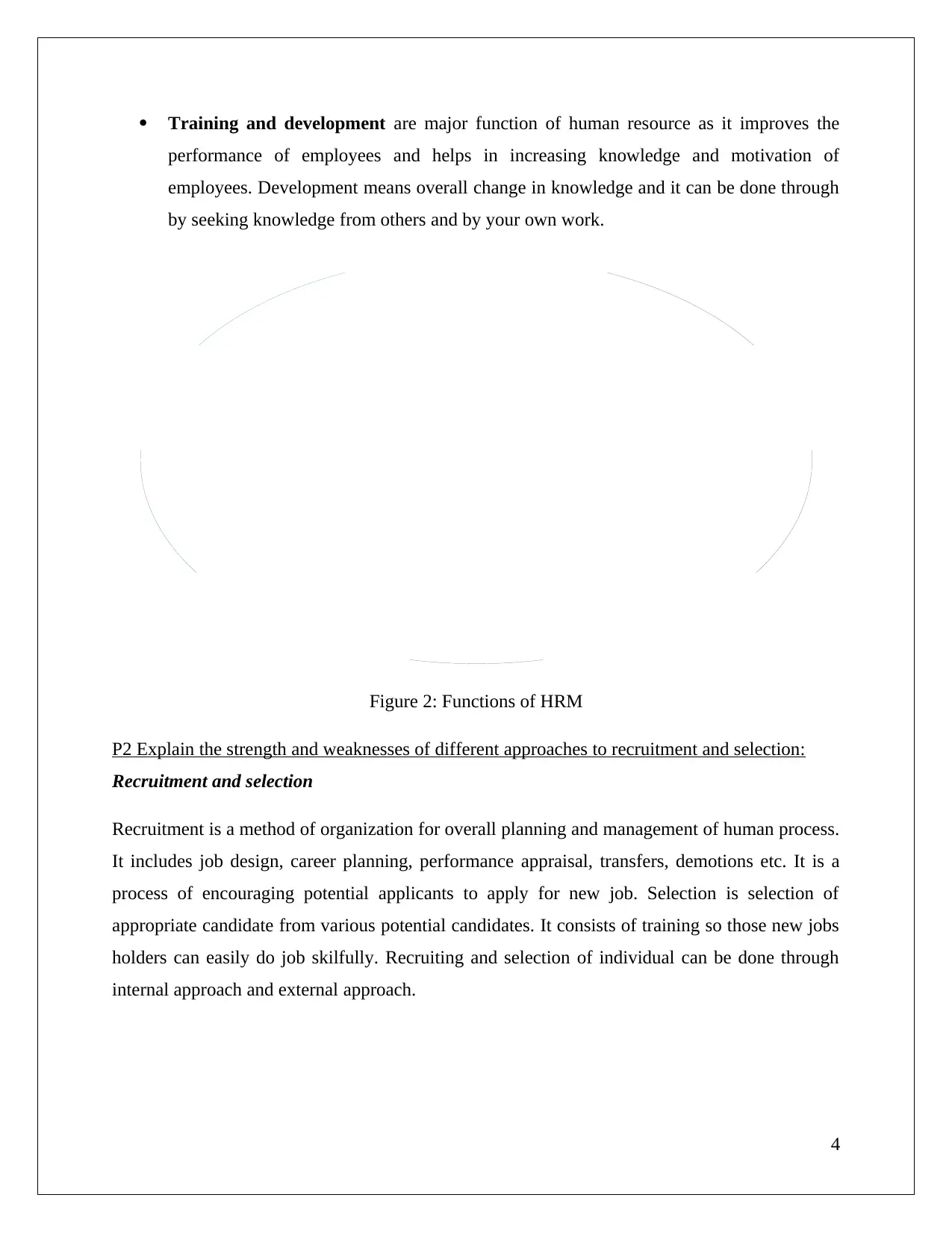
Training and development are major function of human resource as it improves the
performance of employees and helps in increasing knowledge and motivation of
employees. Development means overall change in knowledge and it can be done through
by seeking knowledge from others and by your own work.
Figure 2: Functions of HRM
P2 Explain the strength and weaknesses of different approaches to recruitment and selection:
Recruitment and selection
Recruitment is a method of organization for overall planning and management of human process.
It includes job design, career planning, performance appraisal, transfers, demotions etc. It is a
process of encouraging potential applicants to apply for new job. Selection is selection of
appropriate candidate from various potential candidates. It consists of training so those new jobs
holders can easily do job skilfully. Recruiting and selection of individual can be done through
internal approach and external approach.
4
RecruitingemployeesOrientationGoodworkingconditionsManagingrelationsTraininganddevelopment
performance of employees and helps in increasing knowledge and motivation of
employees. Development means overall change in knowledge and it can be done through
by seeking knowledge from others and by your own work.
Figure 2: Functions of HRM
P2 Explain the strength and weaknesses of different approaches to recruitment and selection:
Recruitment and selection
Recruitment is a method of organization for overall planning and management of human process.
It includes job design, career planning, performance appraisal, transfers, demotions etc. It is a
process of encouraging potential applicants to apply for new job. Selection is selection of
appropriate candidate from various potential candidates. It consists of training so those new jobs
holders can easily do job skilfully. Recruiting and selection of individual can be done through
internal approach and external approach.
4
RecruitingemployeesOrientationGoodworkingconditionsManagingrelationsTraininganddevelopment
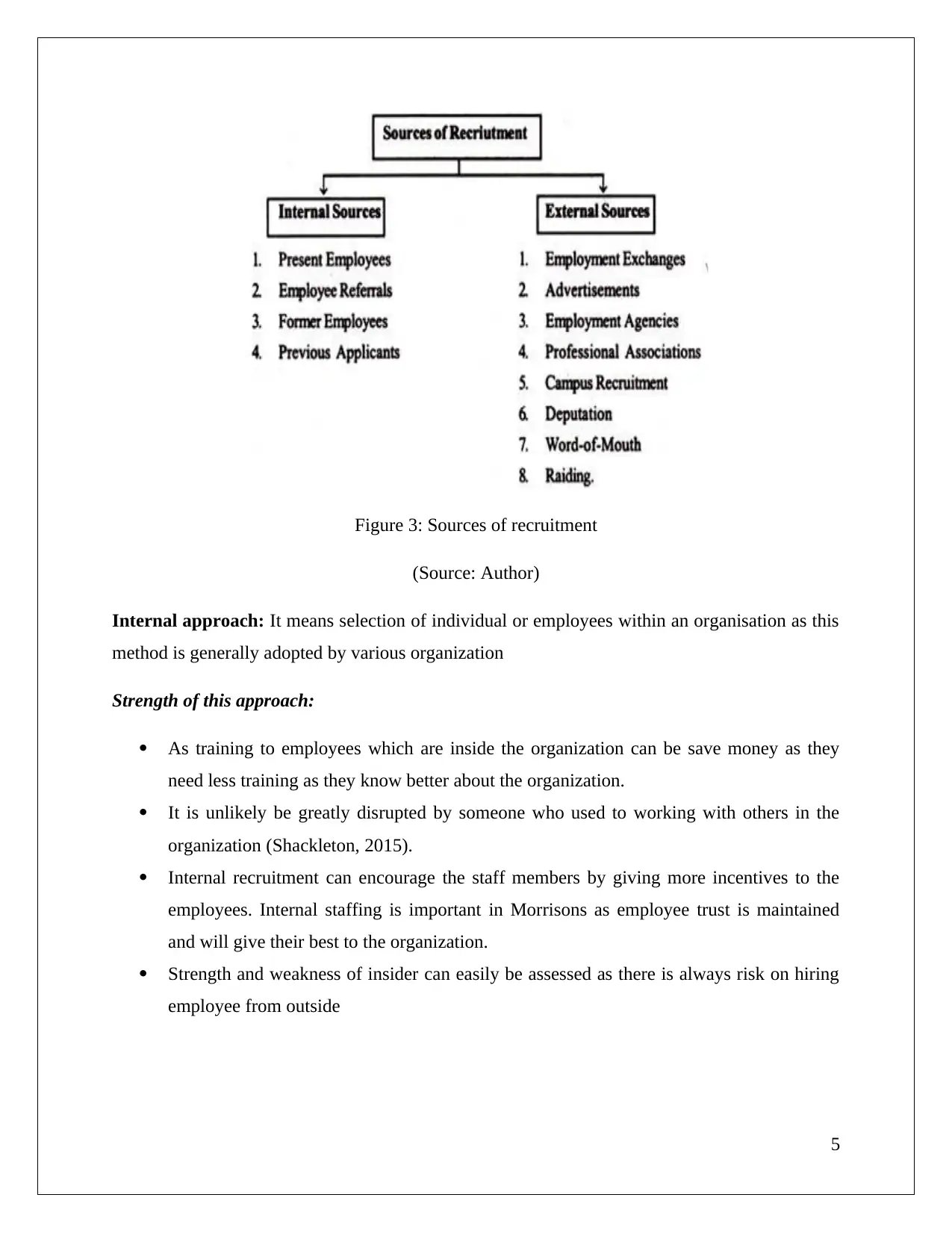
Figure 3: Sources of recruitment
(Source: Author)
Internal approach: It means selection of individual or employees within an organisation as this
method is generally adopted by various organization
Strength of this approach:
As training to employees which are inside the organization can be save money as they
need less training as they know better about the organization.
It is unlikely be greatly disrupted by someone who used to working with others in the
organization (Shackleton, 2015).
Internal recruitment can encourage the staff members by giving more incentives to the
employees. Internal staffing is important in Morrisons as employee trust is maintained
and will give their best to the organization.
Strength and weakness of insider can easily be assessed as there is always risk on hiring
employee from outside
5
(Source: Author)
Internal approach: It means selection of individual or employees within an organisation as this
method is generally adopted by various organization
Strength of this approach:
As training to employees which are inside the organization can be save money as they
need less training as they know better about the organization.
It is unlikely be greatly disrupted by someone who used to working with others in the
organization (Shackleton, 2015).
Internal recruitment can encourage the staff members by giving more incentives to the
employees. Internal staffing is important in Morrisons as employee trust is maintained
and will give their best to the organization.
Strength and weakness of insider can easily be assessed as there is always risk on hiring
employee from outside
5
⊘ This is a preview!⊘
Do you want full access?
Subscribe today to unlock all pages.

Trusted by 1+ million students worldwide
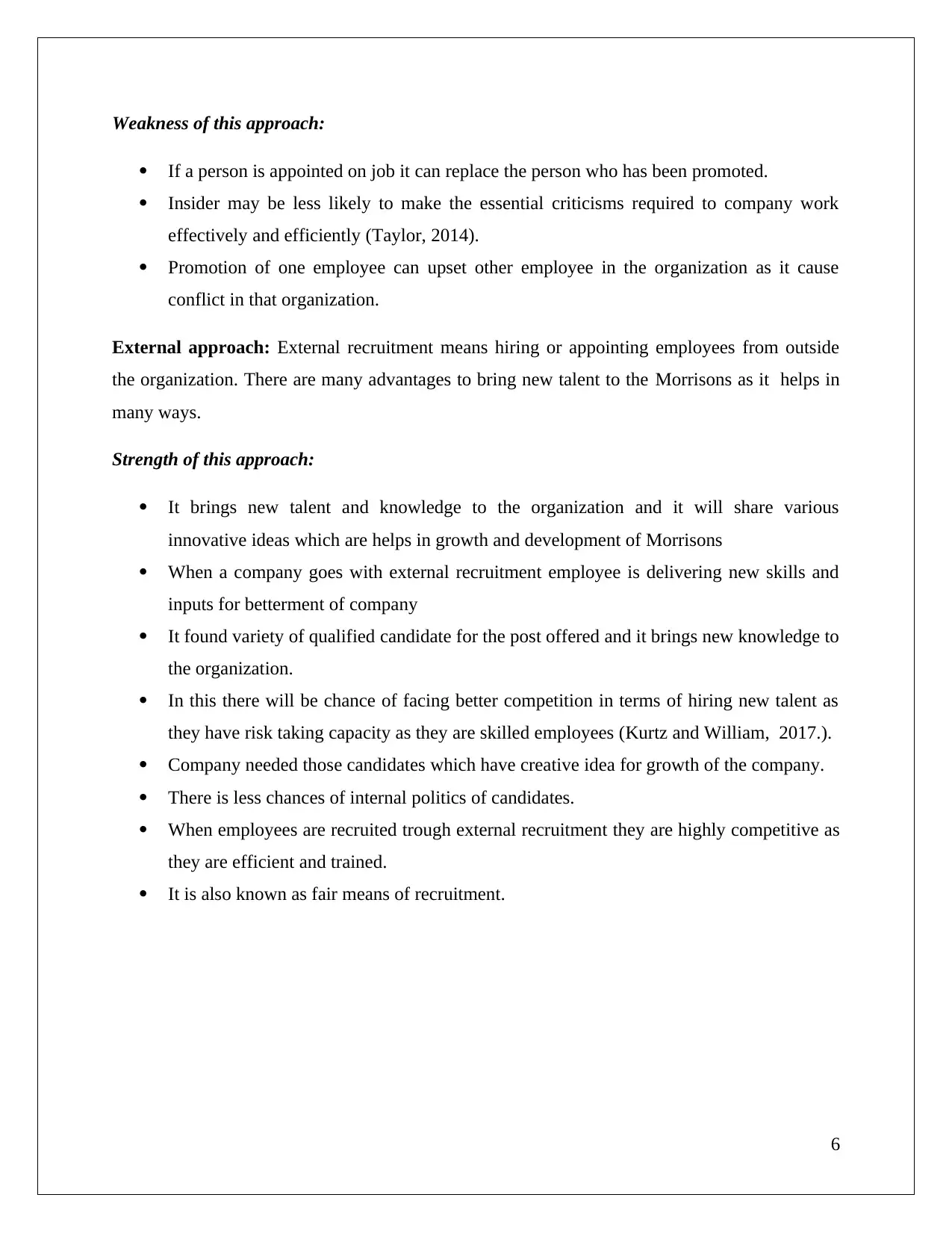
Weakness of this approach:
If a person is appointed on job it can replace the person who has been promoted.
Insider may be less likely to make the essential criticisms required to company work
effectively and efficiently (Taylor, 2014).
Promotion of one employee can upset other employee in the organization as it cause
conflict in that organization.
External approach: External recruitment means hiring or appointing employees from outside
the organization. There are many advantages to bring new talent to the Morrisons as it helps in
many ways.
Strength of this approach:
It brings new talent and knowledge to the organization and it will share various
innovative ideas which are helps in growth and development of Morrisons
When a company goes with external recruitment employee is delivering new skills and
inputs for betterment of company
It found variety of qualified candidate for the post offered and it brings new knowledge to
the organization.
In this there will be chance of facing better competition in terms of hiring new talent as
they have risk taking capacity as they are skilled employees (Kurtz and William, 2017.).
Company needed those candidates which have creative idea for growth of the company.
There is less chances of internal politics of candidates.
When employees are recruited trough external recruitment they are highly competitive as
they are efficient and trained.
It is also known as fair means of recruitment.
6
If a person is appointed on job it can replace the person who has been promoted.
Insider may be less likely to make the essential criticisms required to company work
effectively and efficiently (Taylor, 2014).
Promotion of one employee can upset other employee in the organization as it cause
conflict in that organization.
External approach: External recruitment means hiring or appointing employees from outside
the organization. There are many advantages to bring new talent to the Morrisons as it helps in
many ways.
Strength of this approach:
It brings new talent and knowledge to the organization and it will share various
innovative ideas which are helps in growth and development of Morrisons
When a company goes with external recruitment employee is delivering new skills and
inputs for betterment of company
It found variety of qualified candidate for the post offered and it brings new knowledge to
the organization.
In this there will be chance of facing better competition in terms of hiring new talent as
they have risk taking capacity as they are skilled employees (Kurtz and William, 2017.).
Company needed those candidates which have creative idea for growth of the company.
There is less chances of internal politics of candidates.
When employees are recruited trough external recruitment they are highly competitive as
they are efficient and trained.
It is also known as fair means of recruitment.
6
Paraphrase This Document
Need a fresh take? Get an instant paraphrase of this document with our AI Paraphraser
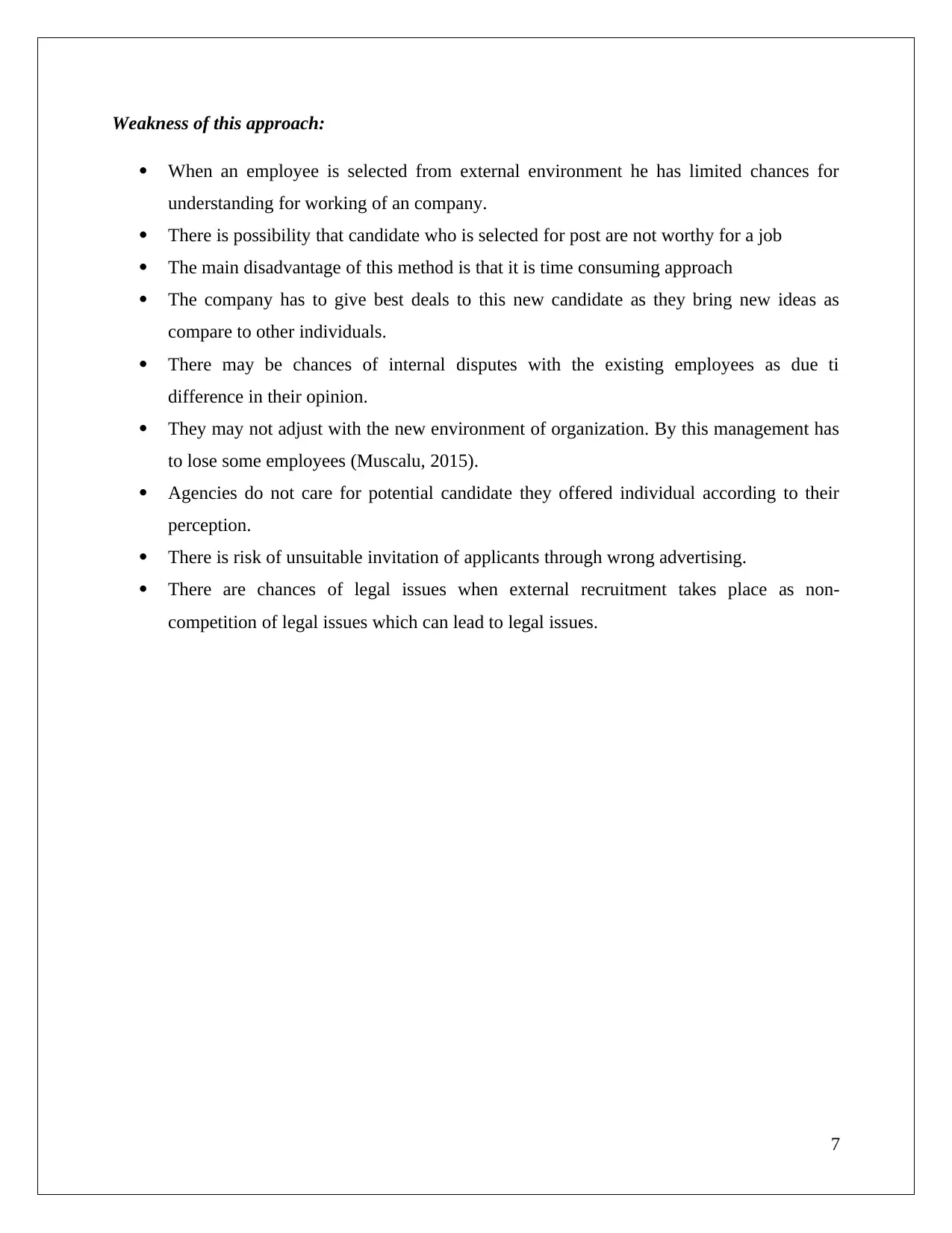
Weakness of this approach:
When an employee is selected from external environment he has limited chances for
understanding for working of an company.
There is possibility that candidate who is selected for post are not worthy for a job
The main disadvantage of this method is that it is time consuming approach
The company has to give best deals to this new candidate as they bring new ideas as
compare to other individuals.
There may be chances of internal disputes with the existing employees as due ti
difference in their opinion.
They may not adjust with the new environment of organization. By this management has
to lose some employees (Muscalu, 2015).
Agencies do not care for potential candidate they offered individual according to their
perception.
There is risk of unsuitable invitation of applicants through wrong advertising.
There are chances of legal issues when external recruitment takes place as non-
competition of legal issues which can lead to legal issues.
7
When an employee is selected from external environment he has limited chances for
understanding for working of an company.
There is possibility that candidate who is selected for post are not worthy for a job
The main disadvantage of this method is that it is time consuming approach
The company has to give best deals to this new candidate as they bring new ideas as
compare to other individuals.
There may be chances of internal disputes with the existing employees as due ti
difference in their opinion.
They may not adjust with the new environment of organization. By this management has
to lose some employees (Muscalu, 2015).
Agencies do not care for potential candidate they offered individual according to their
perception.
There is risk of unsuitable invitation of applicants through wrong advertising.
There are chances of legal issues when external recruitment takes place as non-
competition of legal issues which can lead to legal issues.
7
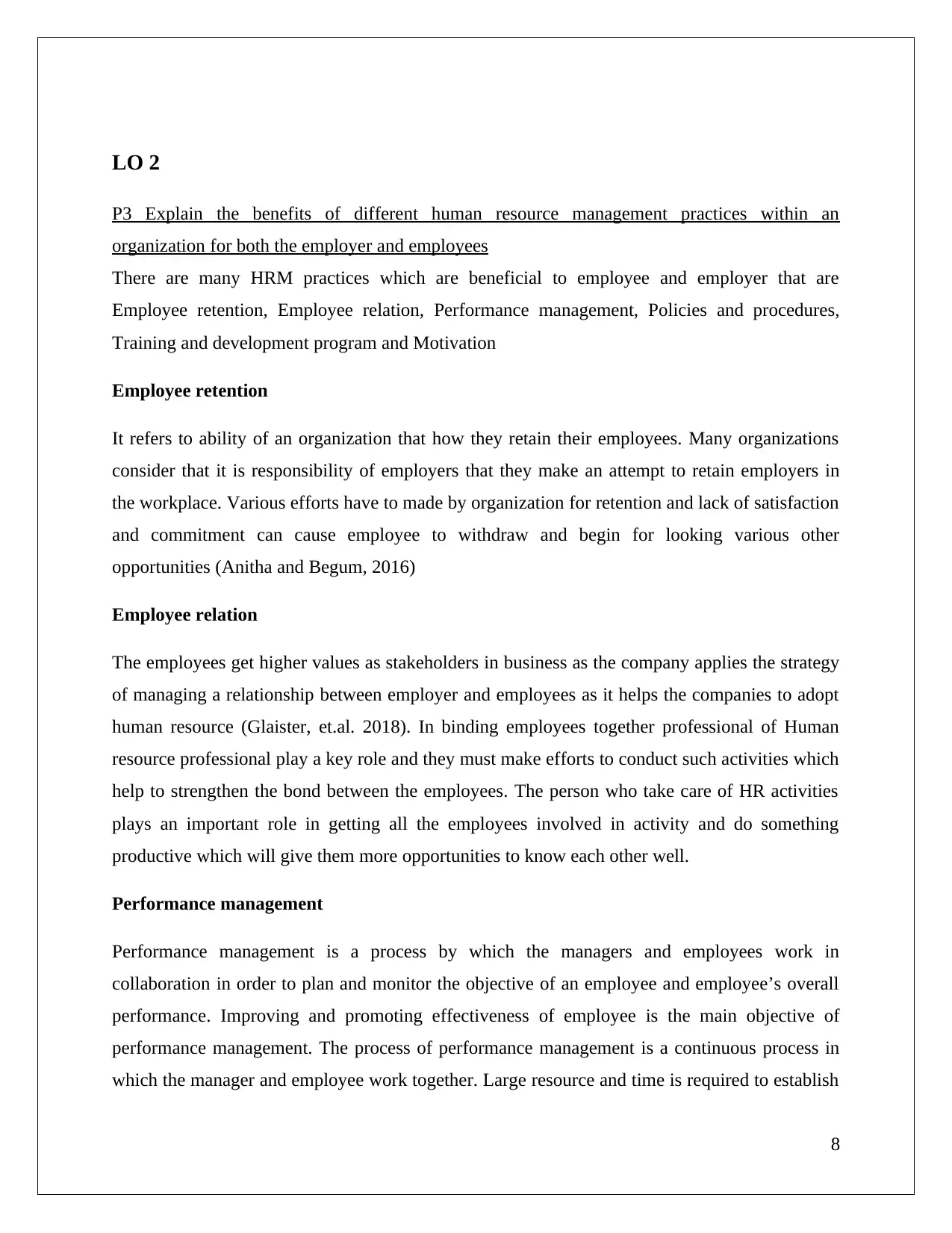
LO 2
P3 Explain the benefits of different human resource management practices within an
organization for both the employer and employees
There are many HRM practices which are beneficial to employee and employer that are
Employee retention, Employee relation, Performance management, Policies and procedures,
Training and development program and Motivation
Employee retention
It refers to ability of an organization that how they retain their employees. Many organizations
consider that it is responsibility of employers that they make an attempt to retain employers in
the workplace. Various efforts have to made by organization for retention and lack of satisfaction
and commitment can cause employee to withdraw and begin for looking various other
opportunities (Anitha and Begum, 2016)
Employee relation
The employees get higher values as stakeholders in business as the company applies the strategy
of managing a relationship between employer and employees as it helps the companies to adopt
human resource (Glaister, et.al. 2018). In binding employees together professional of Human
resource professional play a key role and they must make efforts to conduct such activities which
help to strengthen the bond between the employees. The person who take care of HR activities
plays an important role in getting all the employees involved in activity and do something
productive which will give them more opportunities to know each other well.
Performance management
Performance management is a process by which the managers and employees work in
collaboration in order to plan and monitor the objective of an employee and employee’s overall
performance. Improving and promoting effectiveness of employee is the main objective of
performance management. The process of performance management is a continuous process in
which the manager and employee work together. Large resource and time is required to establish
8
P3 Explain the benefits of different human resource management practices within an
organization for both the employer and employees
There are many HRM practices which are beneficial to employee and employer that are
Employee retention, Employee relation, Performance management, Policies and procedures,
Training and development program and Motivation
Employee retention
It refers to ability of an organization that how they retain their employees. Many organizations
consider that it is responsibility of employers that they make an attempt to retain employers in
the workplace. Various efforts have to made by organization for retention and lack of satisfaction
and commitment can cause employee to withdraw and begin for looking various other
opportunities (Anitha and Begum, 2016)
Employee relation
The employees get higher values as stakeholders in business as the company applies the strategy
of managing a relationship between employer and employees as it helps the companies to adopt
human resource (Glaister, et.al. 2018). In binding employees together professional of Human
resource professional play a key role and they must make efforts to conduct such activities which
help to strengthen the bond between the employees. The person who take care of HR activities
plays an important role in getting all the employees involved in activity and do something
productive which will give them more opportunities to know each other well.
Performance management
Performance management is a process by which the managers and employees work in
collaboration in order to plan and monitor the objective of an employee and employee’s overall
performance. Improving and promoting effectiveness of employee is the main objective of
performance management. The process of performance management is a continuous process in
which the manager and employee work together. Large resource and time is required to establish
8
⊘ This is a preview!⊘
Do you want full access?
Subscribe today to unlock all pages.

Trusted by 1+ million students worldwide
1 out of 27
Related Documents
Your All-in-One AI-Powered Toolkit for Academic Success.
+13062052269
info@desklib.com
Available 24*7 on WhatsApp / Email
![[object Object]](/_next/static/media/star-bottom.7253800d.svg)
Unlock your academic potential
Copyright © 2020–2025 A2Z Services. All Rights Reserved. Developed and managed by ZUCOL.



